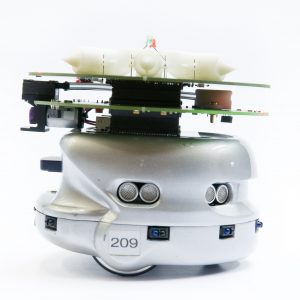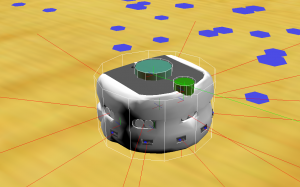
This project aims at exploring algorithms to localize sources that release airborne molecules or particles. Special attention is given to multi-agent algorithms, and a main goal is to find out how and in which circumstances multi-agent algorithms are preferred over single-agent algorithms.
Experiments are carried out both in simulation and with real robots. For the latter purpose, a Khepera III robot has been equipped with a VOC (volatile organic compound) sensor and an anemometer (wind sensor). Real-robot experiments are carried out in the EPFL wind tunnel.
Experiments with single-robot algorithms so far have shown that pure zig-zagging is not a very effective strategy. The spiral-surge algorithm and the newly proposed crosswind-surge algorithm are faster and more robust.
Motivation of the project
While the olfactory sense is of crucial importance for many animals (e.g. for mating, kin recognition, scavenging), odor recognition, localization and discrimination has many current applications in industry as well. Among the most visible applications are search and rescue operations, customs inspection, police operations, or humanitarian demining.
Nowadays, different types of animals (notably dogs and rats, but also bees, …) are employed for such applications. However, training and using these animals is non-trivial and expensive. The ultimate goal of odor localization research therefore is to develop mobile robots to replace the animals in such applications
Additional information here and here.

Team and Collaborators
Sponsors and Research Period
NCCR MICS, a project of the Swiss National Science Foundation
Videos
Video of wind tunnel experiments
Publications
Please note that the publication lists from Infoscience integrated into the EPFL website, lab or people pages are frozen following the launch of the new version of platform. The owners of these pages are invited to recreate their publication list from Infoscience. For any assistance, please consult the Infoscience help or contact support.